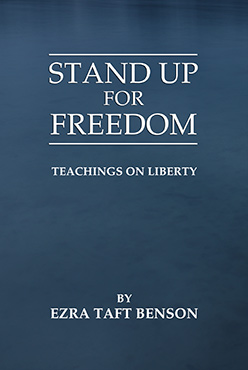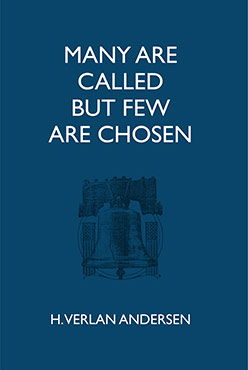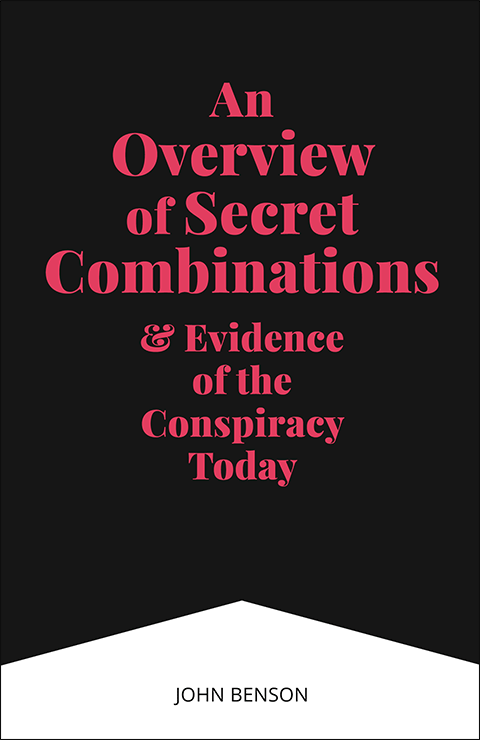The U.S. President, Then and Now
W. Cleon Skousen. The U.S. President, Then and Now. [From Law & Order, December 1976].
No nation ever created a position of power quite like that of the “President of the United States.” In fact, the power connected with this office has grown enormously. At the outset of the Washington terms in the Presidency, there were approximately 350 civilians employed by the existing administrative offices. Today the number of civilian employees stands at 2.5 million and more than three million men and women serve in the Armed Forces of the United States. Relatively few of these are employed in the District of Columbia. Approximately 10 percent of the civilian employees and a much smaller percentage of the military personnel are found within the immediate vicinity of Washington, D.C. The others are spread throughout the 50 states, American territories overseas, and in foreign countries. 1
How the Thinking of the Founding Fathers Changed
If the Constitution had been written in 1776 instead of 1787, the office of President would have been little more than that of a clerk saddled with the responsibility of routinely carrying out the will of Congress. The founders were suspicious of”Executives.” In fact, nearly all of the new States originally wrote their State constitutions with very weak powers granted to their governors. They were suffering from a backlash growing out of their bitter experience with the arbitrary, autocratic and highhanded policies of George III. Pennsylvania went further than any of the States by having no governor at all. She arranged to run her affairs with an executive committee of the legislature.
Ten years later, however, most of the leaders on both the State and national level had come to the conclusion that public affairs cannot be administered efficiently by legislative committees or weak executives. Sufficient power and responsibility must be lodged in one person to get the job done. Deciding just how that special person should be selected and precisely what powers should be delegated to him, created a furor of debate in the Constitutional Convention. It occupied more time than any other subject. Some even doubted that the presidential powers should be entrusted to one man.
How Many Presidents Should We Have?
At this point in time it may seem rather ridiculous to wonder how many Presidents we should have in charge of the Executive Branch of the government. The answer seems so obvious. But it was not so obvious in 1787. James Wilson of Pennsylvania proposed that there should be a single, strong President operating within a carefully defined framework of limited authority. However, Edmund Randolph, governor of Virginia, was most insistent that there should be three Presidents: one to represent New England, one to represent New York and the middle States, and one to represent the South. Hamilton, along with many others, thought this was totally unrealistic. He felt that the experience of the young country had already demonstrated the need for a leader who could handle the country’s offices with “decision, activity, secrecy, and dispatch.” He also agreed with James Wilson of Pennsylvania that “plurality tends to conceal faults and destroy responsibility.”
It was finally decided that a single President would be chosen with strong powers but restricted to tightly limited, well-defined areas.
How Long Should the President Serve?
Hamilton felt that once a good man had been chosen he should be allowed to serve during “good behavior” or for life. Wilson felt this would never do and recommended three years as the President’s term of office with authorization to run for re-election if he desired. George Mason of Virginia favored a single term of seven years without allowing the President to succeed himself. He felt this was important so that the President would not waste his time as the chief executive campaigning for another election.
One of the reasons a number of delegates favored a long term for the President was because they expected Washington to occupy this high office and they wanted him to serve as long as possible. However, after extensive debate it was finally concluded that the term should be for only four years and the President should be restricted to only one term of office. The convention noted that Washington voted against the single term, however, and it was assumed that he felt it would take longer than four years to get the new government into operation. Consequently, when the Constitution was written in its final form, no reference was made to the number of terms a President could serve. In practice, two terms were as long as any President served prior to Franklin D. Roosevelt who died in office during his fourth term. His own party immediately initiated an amendment to the Constitution limiting all future Presidents to two terms.
How Should the President Be Selected?
Even today people are still arguing over the best way to elect a President. At the Constitutional Convention every possible angle was explored. Some thought he should be selected by the House of Representatives. Others preferred the Senate. When it was pointed out that if either of these bodies appointed the President it would violate the principle of “separation of powers,” the suggestion was made that the governors of the various States should make the selection. This, too, met with objections.
It is interesting to note that very few of the delegates were in favor of a popular election of the President. Hamilton felt that if the masses of the people were required to elect the President, the whole fiasco would end in a “tumult and disorder.” Nevertheless, they wanted a system which gave proportional representation to the people in choosing the President. They had confidence in the people electing local and State representatives but thought it would be impossible for all of the people to know all of the Presidential candidates sufficiently well to make an intelligent choice.
It was therefore decided to have the States elect representatives or “electors” in whom they had confidence, and these could then investigate the candidates and make the final selection. This body of representatives has become know as the “electoral college.”
The Electoral College Had Two Weaknesses
Originally, the Constitution provided that each elector would have two votes, thereby indicating his first and second choice for President. It further provided that the candidate who had a majority of the votes would be President and the man with the next highest number of votes would be the Vice-President. In practice, this resulted in a President being teamed up with a Vice-President who might have views opposite to his own.
In fact, as soon as the party system developed, it resulted in the electors from the majority party all voting for the same two men and this created a tie which threw the election into the House of Representatives where the same majority party would continue having a tie. In 1800 the tie was between Thomas Jefferson and Aaron Burr and the House had to ballot 35 times before the tie was finally broken. This problem was remedied by passing the Twelfth Amendment which allows each party to designate one person for President and another for Vice-President.
The Second Weakness
A second weakness in the electoral system was the concept of “winner takes all.” This means that whoever gets a majority of the electors in a particular State can claim all of the electoral votes for that State. In practice this has occasionally allowed a President to win the popular vote but lose because he had only a minority of the electoral votes. Eventually there will probably be an amendment which allows a candidate to claim the same proportion of electors as the percentage of votes won in the popular balloting vote. There would still be difficulties in close races, however, since an electoral vote representing approximately 300,000 people might be given to a Candidate who barely won over his opponent in that State.
It should be pointed out that an elector is free to vote for anyone he wishes but in practice he nearly always votes for his party’s candidates. Since 1789, only six electoral votes out of the more than 17,000 which have been cast, were independent votes.
Many people have wanted to do away with the electoral college altogether and simply choose the President on the basis of the popular vote. It seems, however, that the majority feel more comfortable with the indirect method even though it still has the one weakness mentioned above. When the electoral college issue had been tested in Congress on several occasions, it was found that although a majority was willing to do away with the electoral college, it was in no way possible to get a majority to agree on what system would be acceptable in its place.
What Powers Should Be Given The Presidency?
Now we come to the most difficult question of all. Just how much power should the President have? The specific powers granted to him were rather limited. He was authorized:
1. To be the commander-in-chief of the armed services.
2. To require reports from the principal officer of the Executive departments of government.
3. To have authority to grant reprieves and pardons for offenses against the United States.
4. To make treaties with foreign nations providing two-thirds of the Senate concurred.
5. To appoint ambassadors, judges and the principal officers of government providing they are approved by two-thirds of the Senate.
6. To report to the Congress the state of the Union and recommend to the Congress specific legislation which needs to be passed.
7. To call the Congress into special session when emergency action is needed.
8. To adjourn the Congress when the two Houses cannot agree on the time of adjournment between themselves.
9. To receive ambassadors and public ministers from foreign nations.
10. To see that the laws of the United States are faithfully executed.
11. To assign commissions to all officers of the United States armed services.
The loophole in the “powers of the President” is found in item number ten, which requires the President to make certain that the laws passed by Congress are faithfully executed. This means that any act of Congress which is signed into law must be implemented with the necessary administrative machinery and a budgetary request submitted to finance it. This has resulted in the President becoming far more powerful in his executive capacity than was ever contemplated by the founding fathers. At the same time it has allowed the Congress, when dominated by a party different than the President, to take credit for all kinds of wonderful programs which are supposed to be popular with the people and then blame the President for the massive “bureaucracy” and the excessive budgetary requirements needed to carry on such programs.
How the President Became the Power-Center of the Whole World
It would be interesting to know how the American founding fathers would have reacted if someone in the Constitutional Convention had been able to disclose the fact that within 200 years the President and the Executive Branch of the United States government would have become the power-center of the whole world. Much of this has been the result of America’s economic capacity.
It was clearly demonstrated during World War II that she could speed up her free-enterprise system of industrial capacity and out-produce the rest of the world in both food and armaments. This pushed her into a dominant position at the close of the war and made the United States the peace-keeper of the world whether she liked it or not. It was inevitable that the role of President would attract a whole new dimension of power as these historical changes unfolded.
Dangerous Trends
However, dangerous precedents were soon established which gave the President maneuvering space far beyond the boundaries established by the Constitution. For the first time the President of the United State began having summit conferences with other heads of States. Formal, commitments were made at the conference or through subsequent diplomatic exchanges which took the form of “executive agreements” rather than “treaties.” Therefore they were never submitted to the Senate for discussion or approval. In 1974 there were only 13 “treaties” but there were 230 “executive agreements.” Usually the public has no way of discovering precisely what commitments have been made with these foreign countries. Nor can the Senate find out in many instances.
Another dangerous precedent has been assigning American troops to engage in hostilities without Congressional action. This has happened many times even before Korea and Vietnam.
A recent development which would have shocked the founders has been the use of American prestige to force weaker nations to accept the views of a President and his Secretary of State as to how the problems of another country should be resolved when the President and his Secretary of State have no legal or Constitutional basis for interfering. Take, for example, the current intervention of the U.S. Secretary of State in compelling a minority government of Europeans in Rhodesia to turn over its authority to a majority of natives who are completely unprepared to provide a responsible administration of the nation’s affairs. This was not only an unconstitutional exercise of executive power, but an extremely dangerous gamble as borne out by the fact that when a similar European minority government was forced out of power in Angola, the new government representing the native majority immediately set about slaughtering 10,000 fellow natives.
Political authorities have pointed out that the same tragedy may occur in Rhodesia as it evolves toward a one-man tyranny just as other African countries have done when political power has been turned over prematurely to unprepared native majorities. But even if the outcome were more promising, the fact remains that the Constitution never delegated to the United States President the authority of imposing a majority form of government on the whole world. Were that the case, what must be said about Russia, China, Cuba, and a host of other nations which are not only ruled by minorities but by brutal dictatorships?
Congressional Reaction
Gradually Congress has become aware that its checks-and-balance powers have needed to be reasserted. In 1972 the Case Act was passed, which required the President to submit all international agreements to Congress “for its information.”
Congress passed the War Powers Act in 1973, requiring the Chief Executive to consult with Congress “in every possible instance” before committing armed forces to hostilities. If forces are ordered into action in an emergency, the matter has to be reported to Congress in 48 hours and all hostilities must cease within 60 days unless Congress has approved it.
In 1974 Congress passed the Congressional Budget and Impounding Control Act which gave the Congress tighter control over expenditures and prohibits the President from impounding funds which Congress has appropriated for specific purposes which the President is not carrying out.
Increased Powers of the President In Domestic Matters
Equally dangerous precedents have been established on the home front which Congress must eventually consider. As if it were not enough for the President to be Chief of State, Commander-in-Chief of the Armed Services, Chief Executive Administrator of the whole federal government, Chief legislation writer, Chief diplomat, and Chief of his own party, the Congress has added a host of other responsibilities which relegates to the scrap heap many of the most fundamental concepts of the original Constitution.
Today the President is responsible for maintaining full employment for the work force of the entire nation, the task of providing for a high level of agricultural prosperity, of developing a national housing program, of supervising the exclusive distribution of atomic energy resources, of having the overwhelming responsibility of taking care of the health and social security of the aged and indigent, of settling major labor-management disputes, of rapidly taking over the States’ original jurisdiction covering insurance, unemployment, welfare, safety, environment, education, and a growing number of police powers.
That such a task is impossible and unworkable is becoming more evident with each passing day. The growing articulation of vigorous protests against overregulation, excessive red-tape, and over-taxation is inevitably going to compel the Congress to take remedial action. There is an impelling need to return to the simpler and more efficient devices of the original American life-style where most of these problems were handled far more effectively and economically by the private sector. Those problems deserving governmental intervention could also be handled more effectively if they were kept within the control of the people at the local level rather than dumping the whole gargantuan load on Washington.
All human experience demonstrates through thousands of experiments that the over-centralization of power in government stifles productivity, inhibits initiative, and debases the unalienable human rights of man. The power of the President and the Executive Branch of government is being utilized for this purpose and it is producing a deep credibility gap between Washington and the people. It is time to take an inventory of these serious aberrations in our political structure and square our shoulders to the necessity of shoring up our Constitutional foundations before they crumble beyond repair.





